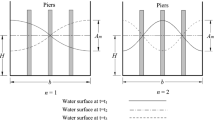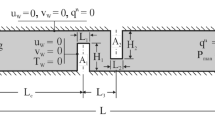Abstract
Hexagonal arrays of circular cylinders (HACCs) can be preferred over mono-piles in the design of marine and hydraulic structures due to certain reasons, e.g. efficiency in scour reduction, decreased stagnation and drag, easier applicability, cost-efficiency. In this study, the influence of the HACC on the flow domain was experimentally investigated and compared to that of a solid cylinder using flume experiments. The primary objective of the experiments was to understand the role of orientation and density of array on bleed flow characteristics, which can be regarded as the major origin of the coherent flow structures generated around the HACC. Mean and turbulent flow quantities were mapped behind the obstacles in each experimental test, collecting high-frequency velocity measurements over a spatially dense grid. A key outcome of the study is the identification of the solid volume fraction (SVF) above which the array behaves like a solid cylinder. Furthermore, the results show that the angle of attack, or HACC orientation, influences only the flow structure for intermediate SVFs. Above and below this intermediate range, the flow structure is insensitive to HACC orientation. It was also witnessed that while the highest resistance to flow was generated by staggered configuration, the highest lateral velocity gradient values occurred in the angled cases.














Similar content being viewed by others
References
Acanal L, Loukogeorgaki E, Yagci O, Kirca VSO, Akgül A (2013) Performance of an inclined thin plate in wave attenuation. J Coast Res 65:141–146. https://doi.org/10.2112/SI65-025.1
Aksel M, Yagci O, Kirca VSO, Erdog E, Heidari N (2021) A comparative analysis of coherent structures around a pile over rigid-bed and scoured-bottom. Ocean Eng 226:108759. https://doi.org/10.1016/j.oceaneng.2021.108759
Arnskov MM, Fredsøe J, Sumer BM (1993) ‘Bed shear stress measurements over a smooth bed in three-dimensional wave-current motion.’ Coast Engrg 20:277–316
Ataie-Ashtiani B, Beheshti AA (2006) Experimental investigation of clear-water local scour at pile groups. J Hydraul Eng 132:1100–1104. https://doi.org/10.1061/(ASCE)0733-9429(2006)132:10(1100)
Chang K, Constantinescu G (2015) Numerical investigation of flow and turbulence structure through and around a circular array of rigid cylinders. J Fluid Mech 776:161–199. https://doi.org/10.1017/jfm.2011.77
Chang FFM, Karim M (1972) An experimental study of reducing scour around bridge piers using piles Rep. South Dakota Dept. of Highways, p 63
Chen Z, Ortiz A, Zong L, Nepf H (2012) The wake structure behind a porous obstruction and its implications for deposition near a finite patch of emergent vegetation. Water Resour Res 48:W09517. https://doi.org/10.1029/2012WR012224
Chen X, Chen Q, Zhan J, Liu D (2016) Numerical simulations of wave propagation over a vegetated platform. Coast Eng 110:64–75. https://doi.org/10.1016/j.coastaleng.2016.01.003
Chiew YM (1989) Local scour at vertical piles under wave action. In: Proc., 9th Australian Conf. on Coastal and Ocean Engineering, Adelaide, Australia, p 393–396
Dean RG, Dalrymple RA (2001) Coastal processes with engineering applications. Cambridge University Press, Cambridge, p 476
Dey S, Sumer BM, Fredsøe J (2006) Control of scour at vertical circular piles under waves and current. J Hydraul Eng ASCE 132(3):270–279
Elfrink B, Baldock T (2002) Hydrodynamics and sediment transport in the swash zone: a review and perspectives. Coast Eng 45:149–167. https://doi.org/10.1016/S0378-3839(02)00032-7
Ettema R (1980) Scour at bridge piers. Report no. 216, School of Engineering, University of Auckland, Auckland, New Zealand
Garg V, Setia B, Verma DVS (2008) Prevention of scour by combination of scour protection devices around bridge piers. In: Proc. River Flow, Izmir, TR, p 1637–1643
Gargari MH, Kirca VSO, Yagci O (2021) Experimental investigation of gradually-varied unsteady flow passed a circular pile. Coast Engrg. https://doi.org/10.1016/j.coastaleng.2021.103926
Gayen R, Mondal A (2016) Water wave interaction with two symmetric inclined permeable plate. Ocean Eng 124:180–191. https://doi.org/10.1016/j.oceaneng.2016.07.045
Ghorbani B, Kells JA (2008) Effect of submerged vanes on the scour occurring at a cylindrical pier. J Hydraul Res 46(5):610–619. https://doi.org/10.3826/jhr.2008.3003
Goring DG, Nikora VI (2002) Despiking acoustic Doppler velocimeter data. J Hydraul Eng 128:117–126. https://doi.org/10.1061/(ASCE)0733-9429
Gravesen H (2003) The importance of experiments for marine engineering design practice. In: Hydrolab II: towards a balanced methodology in European hydraulic research. Budapest, May 22–23
Günaydın K, Kabdaşlı MS (2007) Investigation of ∏-type breakwaters performance under regular and irregular waves. Ocean Eng 34:1028–1043
Heidarpour M, Afzalimehr H (2005) Local scour protection at bridge piers groups using collar. In: Proc., 31st IAHR Congress, Seoul, p 5463–5470
Igarashi T (1981) Characteristics of the flow around two circular cylinders arranged in tandem : 1st report. Bull JSME 24:323–331. https://doi.org/10.1299/jsme1958.24.323
Kitsikoudis V, Yagci O, Kirca VSO, Kellecioglu D (2016) Experimental investigation of channel flow through idealized isolated tree-like vegetation. Environ Fluid Mech 16:1283–1308. https://doi.org/10.1007/s10652-016-9487-7
Kitsikoudis V, Kirca VSO, Yagci O, Celik MF (2017) Clear-water scour and flow field alteration around an inclined pile. Coast Eng 129:59–73. https://doi.org/10.1016/j.coastaleng.2017.09.001
Liversage K, Chapman MG (2018) Coastal ecological engineering and habitat restoration: incorporating biologically diverse boulder habitat. Mar Ecol Prog Ser 593:173–185. https://doi.org/10.3354/meps12541
Loukogeorgaki E, Michailides C, Angelides DC (2012) Hydroelastic analysis of a flexible mat-shaped floating breakwater under oblique wave action. J Fluids Struct 31:130–124
Melville BW, Coleman SE (2000) Bridge scour. Water Resources Publications, Highlands Ranch
Melville BW, Sutherland AJ (1988) Design method for local scour at bridge piers. J Hydraulic Eng ASCE 114(10):1210–1226
Michailides C, Angelides DC (2012) Modeling of energy extraction and behavior of a Flexible Floating Breakwater. Applied Ocean Res 35:77–94
Mori N, Suzuki T, Kakuno S (2007) Noise of acoustic Doppler velocimeter data in bubbly flows. J Eng Mech 133:122–125. https://doi.org/10.1061/(ASCE)0733-9399
Nezu I (2005) Open channel turbulence and its research prospect in the 21st century. J Hydraul Eng 131:229–246. https://doi.org/10.1061/(ASCE)0733-9429(2005)131:4(229)
Nicolle A, Eames I (2011) Numerical study of flow through and around a circular array of cylinders. J Fluid Mech 679:1–31. https://doi.org/10.1017/jfm.2011.77
Prodger S, Russell P, Davidson M, Miles J, Scott T (2016) Understanding and predicting the temporal variability of sediment grain size characteristics on high-energy beaches. Mar Geol 376:109–117. https://doi.org/10.1016/j.margeo.2016.04.003
Roulund A, Sumer BM, Fredsøe J, Michelsen J (2005) Numerical and experimental investigation of flow and scour around a circular pile. J Fluid Mech 534:351–401
Smallegan SM, Irish JL, Van Dongeren AR, Den Bieman JP (2016) Morphological response of a sandy barrier island with a buried seawall during Hurricane Sandy. Coast Eng 110:102–110
Sumer BM, Fredsøe J (2001) Wave scour around a large vertical circular cylinder. J Waterw Port Coast Ocean Eng 127(3):125–134
Sumer BM, Fredsøe J (2002) The mechanics of scour in the marine environment, vol. 17 of advanced series on ocean engineering. World Scientific
Sumer BM, Fredsøe J (2006) Hydrodynamics around cylindrical structures, vol. 26 of Advanced Series on Ocean Engineering. World Scientific
Sumer BM, Fuhrman DR (2020) Turbulence in coastal and civil engineering, vol. 51 of advanced series on ocean engineering. World Scientific
Sumer BM, Fredsøe J, Christiansen N (1992) Scour around vertical pile in waves. J Waterw Port Coast Ocean Eng 118(1):15–31
Sumer BM, Christiansen N, Fredsøe J (1993) Influence of cross section on wave scour around piles. J Waterw Port Coast Ocean Eng 119(5):477–495
Sumer BM, Bundgaard K, Fredsøe J (2005) Global and local scour at pile groups. Int J Offshore Polar Eng 15:204–209
Tafarojnoruz A, Gaudio R, Dey S (2010) Flow-altering countermeasures against scour at bridge piers: a review. J Hydraulic Res 48(4):441–452. https://doi.org/10.1080/00221686.2010.491645
Tafarojnoruz A, Gaudio R, Calomino F (2012) Evaluation of flow-altering countermeasures against bridge pier scour. J Hydraul Eng 138:297–305
Takemura T, Tanaka N (2007) Flow structures and drag characteristics of a colony-type emergent roughness model mounted on a flat plate in uniform flow. Fluid Dyn Res 39:694–710. https://doi.org/10.1016/j.fluiddyn.2007.06.001
Tanaka N, Yagisawa J (2010) Flow structures and sedimentation characteristics around clump-type vegetation. J Hydro-Environ Res 4:15–25. https://doi.org/10.1016/j.jher.2009.11.002
Teh HM, Venugopal V (2013) Performance evaluation of a semicircular breakwater with truncated wave screens. Ocean Eng 70:160–176. https://doi.org/10.1016/j.oceaneng.2013.05.035
Tennekes H, Lumley JL (1972) A first course in turbulence. MIT Press, Cambridge, p 300
Thomas R, Schindfessel L, McLelland S, Creëlle S, De Mulder T (2017) Bias in mean velocities and noise in variances and covariances measured using a multistatic acoustic profiler: the nortek vectrino profiler. Meas Sci Technol 28(7):075302. https://doi.org/10.1088/1361-6501/aa7273
Turker U, Yagci O, Kabdasli MS (2019) Impact of nearshore vegetation on coastal dune erosion: assessment through laboratory experiments. Environ Earth Sci 78:584. https://doi.org/10.1007/s12665-019-8602-8
Valyrakis M, Kitsikoudis V, Yagci O, Kirca VSO, Koursari E (2015) Experimental investigation of the modification of the flow field, past emergent aquatic vegetation elements. In: Proceedings of the 36th IAHR World Congress, June, The Hague, The Netherlands
Voulgaris G, Trowbridge JH (1998) Evaluation of the acoustic doppler velocimeter (ADV) for turbulence measurements. J Atmos Ocean Technol:272–289. https://doi.org/10.1175/1520-0426(1998)015<0272:EOTADV>2.0.CO;2
Wahl TL (2003) Discussion of ‘Despiking acoustic doppler velocimeter data.’ J Hydraul Eng 29:484–487. https://doi.org/10.1061/(ASCE)0733-9429
Wang RK, Herbich JB (1983) Combined current and wave produced scour around a single pile. CEO Rep. No. 269, Texas Engrg. Experiment Station, Dept. Civ. Engrg., Texas University System
White FM (1986) Fluid mechanics. McGraw-Hill, New York, p 732
Xiao Y, Jia H, Guan D, Liang D, Yuan S, Tang H (2021) Experimental investigation on scour topography around high-rise structure foundations. Int J Sedim Res 36(3):348–361
Yagci O, Kabdasli MS (2008) The impact of single natural vegetation elements on flow characteristics. Hydrol Process 22:4310–4321
Yagci O, Kirca VSO, Kabdasli MS, Celik AO, Unal AO, Aydingakko A (2006) An experimental model application of wavescreen: dynamic pressure, water particle velocity, and wave measurements. Ocean Eng 33:1299–1321. https://doi.org/10.1016/j.oceaneng.2005.08.005
Yagci O, Kirca VSO, Acanal L (2014) Wave attenuation and flow kinematics of an inclined thin plate acting as an alternative coastal protection structure. Appl Ocean Res 48:214–226. https://doi.org/10.1016/j.apor.2014.09.003
Yagci O, Yildirim I, Celik MF, Kitsikoudis V, Duran Z, Kirca VSO (2017) Clear water scour around a finite array of cylinders. Appl Ocean Res 68:114–129. https://doi.org/10.1016/j.apor.2017.08.014
Yueh CY, Chuang SH, Wen CC (2018) Scattering of water waves by surface-piercing barriers using dual BEM. J Hydro-Environ Res 21:21–28. https://doi.org/10.1016/j.jher.2018.06.002
Zong L, Nepf H (2012) Vortex development behind a finite porous obstruction in a channel. J Fluid Mech 691:368–391. https://doi.org/10.1017/jfm.2011.479
Acknowledgements
The data presented here emanated from the master thesis by the second author Özge Karabay. The authors thank to Assist. Prof. Vasileios Kitsikoudis from University of Twente, Assoc. Prof. V.S. Özgür Kirca from Istanbul Technical University for their fruitful discussions. Also, they are grateful to Işılsu Yıldırım for her aid in training of second author in the laboratory. This study was written during the sabbatical stay of the first author, Oral Yagci, at the Baker Environmental Hydraulics Laboratory at Virginia Tech. His sabbatical stay was funded by “The Scientific and Technological Research Council of Turkey (TUBITAK)” under the program of 2219 (Ref. No. 53325897-115.02-39691).
Author information
Authors and Affiliations
Corresponding author
Additional information
Publisher's Note
Springer Nature remains neutral with regard to jurisdictional claims in published maps and institutional affiliations.
Rights and permissions
About this article
Cite this article
Yagci, O., Karabay, Ö. & Strom, K. Bleed flow structure in the wake region of finite array of cylinders acting as an alternative supporting structure for foundation. J. Ocean Eng. Mar. Energy 7, 379–403 (2021). https://doi.org/10.1007/s40722-021-00208-9
Received:
Accepted:
Published:
Issue Date:
DOI: https://doi.org/10.1007/s40722-021-00208-9




